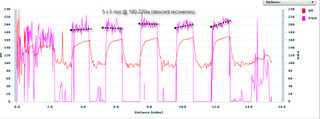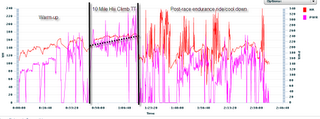Negative splits--finally!
 The chart to the left is from the same athlete who I gave a hard time to last week for doing a hill reps workout with positive splits on each work interval and a positive trend for the entire hill reps portion. In other words, she was starting out at too high of an effort on each work interval and then fading as each progressed. And she was fading as the workout progressed. This is the way most athletes train and race in steady state events such as time trials, triathlons and running races.
The chart to the left is from the same athlete who I gave a hard time to last week for doing a hill reps workout with positive splits on each work interval and a positive trend for the entire hill reps portion. In other words, she was starting out at too high of an effort on each work interval and then fading as each progressed. And she was fading as the workout progressed. This is the way most athletes train and race in steady state events such as time trials, triathlons and running races.
You'll recall that I made the point that you should make the first part of the workout and race feel much easier than the second half by holding back a bit at the start. In a flat race with no wind the first half of the race would be completed in about 51% of the total race time, the second half in about 49%. The above chart is from a workout one week following the workout for which I gave her so much criticism. You can see here that she completed the workout exactly as it should be done. The work intervals trend upward to the right slightly and increase in intensity as the session progressed. Very well done.
 On the right is a race file from that same athlete for a 5 mile hill climb TT done last Saturday. Note that the race portion of this chart has a definite increase in power as the climb progresses. That's excellent. In fact, she may have held back just a bit too much in the first half as the average power slope is a bit steep. Learning to pace a steady state race correctly is a very difficult skill to learn. She has made great progress in one week, however. Learning to pace correctly will produce the best times possible in such events. And in order to get it right in races you must first learn to do it in workouts.
On the right is a race file from that same athlete for a 5 mile hill climb TT done last Saturday. Note that the race portion of this chart has a definite increase in power as the climb progresses. That's excellent. In fact, she may have held back just a bit too much in the first half as the average power slope is a bit steep. Learning to pace a steady state race correctly is a very difficult skill to learn. She has made great progress in one week, however. Learning to pace correctly will produce the best times possible in such events. And in order to get it right in races you must first learn to do it in workouts.

2 Comments:
I think this series of posts has been very interesting. Thanks!
A related question is how to correct for tracks that are hilly. As an example, I often run "time trials" on a 6 km course where the start and goal is 40 meters higher than the mid point of the course. Because of this, a steady effort will yield a faster first half as it is mostly downhill.
How much faster should I expect to run 3 km with a total descent of 40 meters, compared to 3 km with an ascent of 40 meters?
This is obviously a function of my running speed on flat courses. If you can give some estimates for 4 min/km and 5 min/km, that would be very interestng.
micke h--That's a question I really can't answer directly with a pace. But let's put it this way...you should probably go up a hill at about a 10-15% greater effort than on the flats. Going downhill that may be reversed (my greater concern here for a runner is injury). The best way of measuring this for a runner would be with power, which is not available for runners yet (but soon may be). The next best would be normalized graded pace, which you can find out post workout from WKO+ software. But as of now no GPS or accelerometer speed & distance devices provides NGP. Some day soon, I hope.
Post a Comment
<< Home